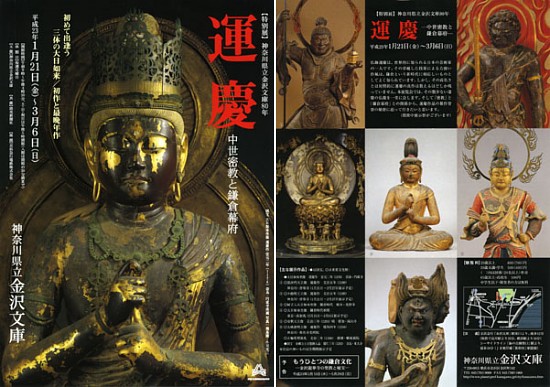Buddha Statues & Japan – January 2011
Hello Subscribers,
Knowledge and product updates for January 2011.
Updates to A-to-Z Dictionary of Japanese Deities
» Kappa 河童. Updated page with two 18th-century drawings and added new Kappa lore. Kappa are Japanese river imps or sprites. They are mostly evil, but not always. They love to eat the liver of their victims, and to do so, they reach their arm up the victim’s anus (shiri 尻) to pull it out — but before they can do so, they must remove the mythical shirikodama (anus jewel). A very strange creature indeed, but one known by all children and adults in modern Japan. To learn more, visit the Kappa page.
Updates to Buddha Statue eStore
» Special Year-End Clearance Sale Continues (33% to 70% Off).
http://www.buddhist-artwork.com/html/special-deals.html
Current & Upcoming Exhibitions
» Unkei — Medieval Esoteric Buddhism & the Kamakura Bakufu
Special Exhibition from Jan. 21 through March 6th at the Kanagawa Prefectural Kanazawa Bunko Museum 神奈川県立金沢文庫 in Yokohama. If you live in Japan, don’t miss this exhibition, which features seven carvings by Unkei, one of Japan’s most lauded sculptors from the Kamakura-period (13th century). It is impossible to exaggerate the importance of Unkei to the world of Japanese Buddhist statuary. He is the undisputed champion of Kamakura-era statuary, which featured a new realism, heroic spirit, power and passion, muscular bodies, plump fleshy faces, and virile strength. Learn much more about Unkei at the A-to-Z Dictionary. The statues on display include:
- Dainichi 大日. Dated +1176, Nat’l Treasure, Enjōji Temple 円成寺 in Nara.
- Fudō 不動. Dated 1189, ICP, Jōrakuji Temple 常楽寺, Kanagawa Pref.
** On display until Feb. 27 ** - Bishamonten 毘沙門天. Dated 1189, ICP, Jōrakuji Temple 常楽寺, Kanagawa Pref.
** On display until Feb. 27 ** - Taishakuten 帝釈天, Dated 1201, ICP, Ryūzanji Temple 滝山寺, Aichi Pref.
Carved by Unkei’s son Tankei 湛慶under Unkei’s guidance.) - Dainichi & Zushi, Early Kamakura Era, ICP, Kōtokuji Temple 光得寺, Tochigi Pref.
- Dainichi Nyorai 大日如来, Early Kamakura Era, ICP, Shinnyo-en 真如苑, Tokyo. This piece was sold at a Christie’s auction in New York in 2008 for $12.8 million.
** On display from Feb. 8 to March 6. ** - Daiitoku Myō-ō大威徳明王, Dated 1216, ICP, Kōmyō-in 光明院, Kanagawa Pref.
- Photos of All Pieces planet.pref.kanagawa.jp/city/bunko/shuyotenjihin.htm
- Exhibit J-Overview planet.pref.kanagawa.jp/city/bunko/tenjiannai.htm
» Secrets of the Silk Road Exhibition
http://penn.museum/china-secrets-of-the-silk-road.html
February 5 to June 5, 2011. Penn Museum (Philadelphia). Secrets of the Silk Road includes two mummies and the full burial trappings of a third, representative of three different periods of time. In addition to the mummies, the exhibition features more than 100 objects that offer insight into the long and diverse cultural heritage of Central Asia—a crossroads of the Silk Road.
» Nara National Museum
http://www.narahaku.go.jp/english/exhibition/special.html
February 5 to March 14, Treasures of Tōdaiji’s Omizutori Ritual. The Omizutori ritual is famed for signaling the advent of spring, but the ceremony is actually called a Shuni-e, which is a ritual of repentance performed before the Jūichimen (11-Headed) Kannon. The Omizutori ritual was first performed by monk Jitchū in 752 AD. Sculpture, paintings, calligraphy, works of applied art, and archaeological artifacts associated with the ritual will be on display.
» Kyoto National Museum
http://www.kyohaku.go.jp/eng/index_top.html
January 8 to February 20, 2011. Spirit of Brush and Ink: the World of Chinese Paintings and Calligraphies.
» Tokyo National Museum
http://www.tnm.go.jp/en/servlet/Con?pageId=A01&processId=02&event_id=7966
January 18 to March 6, 2011. Hirayama Ikuo and the Preservation of Buddhist Heritage.
What’s Happening in Japan in Jan. 2011
» February 3. Bean-Throwing Ceremony (Setsubon 節分). February 3 each year. A major event, but not a national holiday. People nationwide throw beans outside their home and inside their home chanting Oni wa Soto, Fuku wa Uchi 鬼は外福は内 (Get out Ogre! Come in Happiness!). See Setsubun in Japan; A Lunar New Years’ Eve by Steve Renshaw and Saori Ihara.
» February 11. National Founding Day, Kenkoku Kinen no Hi 建国記念の日. National Holiday. Established in 1966.
» March 3. Girl’s Festival or Doll Festival, Hina Matsuri 雛祭り or Momo no Sekku 桃の節句 (Peach Festival). A major event, but not a national holiday. Geared towards girls, the first sekku (seasonal festival) after the birth of a baby girl, it is a day when dolls are set out for display and meant to symbolize the family’s wish that their daughter will be healthy, free from calamity, and able to obtain a happy life with a good husband. Today called the Peach festival, as March is the season when peach flowers are in bloom.
» March 20 or 21. Vernal Equinox Day, Shunbun no Hi 春分の日. Around March 20 or 21. National Holiday. Established in 1948, but in former times a very important day for the imperial family and court.
» For a larger list of Japan’s major holidays, see Mr. Kondo Takahiro’s web site.
asahi-net.or.jp/~QM9T-KNDU/annualev.htm
End Newsletter






